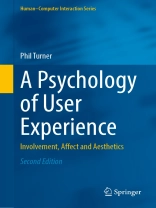As mainstream psychology was never intended for the HCI practitioner, this second edition of A Psychology of User Experience takes the opportunity to create a new chapter specifically written for practitioners, that is, UX-oriented psychology rather than the all-too familiar everyday variety. For example, we discuss our two modes of cognition (fast / slow or controlled / automatic); we underline the importance of familiarity; and how and why we check our phones every few seconds day or night. We also establish the ‘context for user experience’ noting that just about everyone uses a cell phone and very many own a smartphone too and have done so for years (so, how did they learn to use them?).
User experience reflects the current vogue for “designing for experience” within HCI which we recognise as something we feel rather than have reasoned about. In the real world, our feelings tell us how we are doing but with UX, they tell us how we feel about using digital technology. Topics are introduced to UX which maybe unfamiliar such as virtual experiences and virtual emotions and the affect associated with the uncontrolled use of digital technology.
A Psychology of User Experience stands as a companion text to the author’s HCI Redux text which discusses the contemporary treatment of cognition in human-computer interaction.
İçerik tablosu
The everyday use of digital technology.- Creating a good experience.- Involvement (with technology).- Aesthetics.- Affect.- Killing time.












